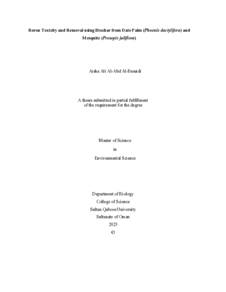Document
Boron toxicity and removal using biochar from date palm (Phoenix dactylifera) and mesquite (Prosopis juliflora).
Other titles
سمية وإزالة البورون باستخدام الفحم الحيوي من نخيل التمر والمسكيت
Publisher
Sultan Qaboos University.
Gregorian
2023
Language
English
Subject
English abstract
Production of effluents and wastewater has been a growing environmental concern due
to a wide range of industrial and other anthropogenic activities. For example, produced
water (PW) is a byproduct usually generated along extracted crude oil and characterized
by high salinity and augmented levels of minerals. Several handling and treatment
approaches have been developed or experimented to handle PW and/or PW-containing
contaminants including boron (B). Adsorption, the adhesion of elements and/or
molecules from effluent or wastewater to the surface of a substance, is a heavily
investigated approach using activated carbon. However, activated carbon is costly to
generate and expensive, and therefore, there has been an increase in research on
adsorption using low-cost natural materials such as biochar, carbon-rich solid black
materials made by the pyrolysis of biomass in an oxygen-limited environment. The
current study investigates biochar from biomass waste (fibers of date palm or phoenix
dactylifera, DPF, and barks of the invasive plant species, mesquite, Prosopis juliflora,
PJB) as an alternative, cost-effective, and environmentally friendly adsorbent for B
removal from PW. The objectives include characterization of PW, DPF and PJB biochar,
testing biochar for adsorption of B from artificial B solutions as well as PW, and running
toxicity tests of B solutions and PW (2-40 ppm B/L, and 5-40% PW for 14 days,
respectively) on mung bean, a model organism widely used in sediment contamination
studies. The DPF and PJB biochar were separately prepared at 600 °C for 2 hours. The
resultant biochar was characterized using (Fourier Transform Infrared Spectroscopy,
Scanning electron microscopy- Energy Dispersive Spectroscopy, Branueur-Emmet Teller surface area, etc.). Physicochemical parameters (heavy metals, salinity, sodium,
total petroleum hydrocarbons, and volatile fatty acids, B, etc) of PW were measured.
Generally, both DPF and PJB biochar can adsorb B from artificial solutions as well as
PW. B adsorption under different conditions of pH (3-13), biochar dose (0.02-0.2 g/L),
B concentration (2-40 ppm), and contact time (30-720 min) revealed that the best
conditions for B removal were 240 minutes at pH 9, a dose of 0.2 g/L, and an initial
concentration of 2 ppm reaching the maximum efficiency ~ 89 and 75% for PJB and
DPF, respectively). But, B removal efficiency was limited in PW, likely due to the
presence of various contaminants and pollutants. The results fit the Langmuir isotherm
(R2= 0.81 and 0.94 for PJB and DPF, respectively) and pseudo-second-order kinetic
models well (R2= 0.99 and 0.95 for PJB and DPF, respectively). After exposure to B
artificial solutions, mung beans exhibited toxic responses (reduction in development and
growth, yellowing of the leaves, reduction in photosynthetic pigments, and proline
accumulation). Mung bean seeds failed to germinate in a higher % of PW (10-40), and
this should not be attributed solely to B. Experimentally and statistically, PJB biochar
behaved better than DPF biochar in B removal in all conditions except pH where there
was no significant difference between the two. Overall, our results encourage the use of
biomass waste for making biochar for the treatment of industrial effluents and
wastewater. In addition, the utilization of biomass of P. juliflora, may help in the
management of this invasive species.
Member of
Resource URL
Category
Theses and Dissertations

